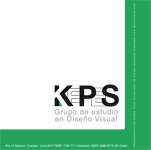Authors
Abstract
Some of the results obtained in the research project "Photography as a medium for the development of visual literacy", in which different strategies were analyzed to enhance the development of visual literacy and critical thinking in students of the graphic design program of the Universidad Autonoma de Aguascalientes (Mexico), are shared in this article. Visual literacy refers to the ability people have for interpreting and generating images from the study of the components that constitute visual language, a competence that is a fundamental input in the practices within the design classrooms thus becoming a relevant item for the research and the qualification of design professionals.
The article shows one of the laboratories implemented where the third-year students of the Graphic Design program, after reading the chapter The Medium is the Message by Marshall McLuhan, visualized one of the concepts of the text. The image that was hosted on a virtual platform for discussion in class.
Among the findings, the reader will know the synthesis of the analysis of four of the 27 images made which allows appreciating, among other things, that students need to develop argumentative skills related to the principles of critical thinking. In addition, in their projective exercise, the interpretation of concepts must be consistent with the active values of their environment, which enables the generation of products that meet the contextual requirements. As a conclusion, it is established that reflective decoding proper to visual literacy and procedures of interpretation and representation of knowledge, inherent in critical thinking, should be assumed as teaching-learning strategies in the courses that form the curriculum of the Graphic Design Bachelor's degree.
Keywords:
References
Berger, J. (1972). Ways of Seeing. London: Penguin Books.
Burn, A. & Durran, Ja. (2007). Media Literacy in Schools. Practice, Production and Progression. London: Paul Chapman Publishing.
Center for Ecoliteracy. Recuperado de: https://www.ecoliteracy.org/about
Chamorro-Koc, M. Scott, A. & Coombs, G. (2015). Bombs Away: Visual thinking and students’ engagement in design studios contexts. Design and Technology Education: an International Journal, 20(1).
De la Cuesta, C. y Otálvaro, C. (2015). La reflexividad y la autocrítica como fundamentos de la investigación cualitativa. Salud Pública, 33(1).
Dussán, C. et al. (2016). Perspectiva de los egresados sobre la pertinencia académica del Programa de Diseño Visual. Revista Kepes. 13(13), pp. 9-28.
IVLA. (2012). What is Visual Literacy? International Visual Literacy Association, Recuperado de http://ivla.org/new/what-is-visual-literacy-2/
Kincheloe, J., McLaren, P. (2005). Rethinking Critical Theory and Qualitative Research. En Denzin, N. y Lincoln, Y. The Sage Handbook of Qualitative Research: California: Thousand Oaks, 303-342.
López-León, R. (2015). Primera aproximación al concepto de visual literacy y su importancia en la educación del arte y diseño. En C. Villagómez & J. Saldaña, Estudios Críticos en Arte y Diseño. Guanajuato: Universidad de Guanajuato.
Martínez, C. (2015). El compromiso interpretativo, un aspecto ineludible en la investigación cualitativa. Salud Pública, 33(1).
McLuhan, M. (1996). El medio es el mensaje. Comprender los medios de comunicación. Las extensiones del ser humano. Barcelona: Paidós.
NCREL & METIRI, (2003). enGauge 21st Century Skills: Literacy in the Digital Age, North Central Regional Educational Laboratory and the Metiri Group: California. Recuperado de http://pict.sdsu.edu/engauge21st.pdf el 10 diciembre 2014.
Riddle, J. (2009). Engaging the Eye Generation, Visual Literacy Strategies in the K-5 Classroom, Stenhouse Publishers. Recuperado de http://booksgreatchoice.com/getbook/p306781/?id=30
Scriven, M. & Paul, R. (1987). Defining Critical Thinking. The Critical Thinking Community. Recuperado de http://www.criticalthinking.org/pages/definingcritical-thinking/766
Steiner, C. & Perry, P. (1997). Achieving Emotional Literacy. London: Bloomsbury.
Stokes, S. (2001). Visual Literacy in Teaching and Learning: A Literature Perspective. Electronic Journal for the Integration of Technology in Education 1(1). Recuperado de http://ejite.isu.edu/Archive.html
Taboada, M. & Coombs, G. (2013). Liminal moments: designing, thinking and learning. In J.B. Reitan, I. Digranes, & Nielsen (Eds.), DRS Cumulus 2013: Design Learning for Tomorrow – Design Education from Kindergarten to PhD. Oslo: LM.
Taylor, S.J. & Bogdán, R. (1987). Introducción a los métodos cualitativos de investigación. Barcelona: Paidós.
Villa, G. et al. (2016). Perspectiva de los empleadores sobre la pertinencia académica del Programa de Diseño Visual. Revista Kepes 13 (13), pp. 29-49.

 pdf (Español (España))
pdf (Español (España))
 FLIP
FLIP
 Perfil Google Scholar
Perfil Google Scholar


















